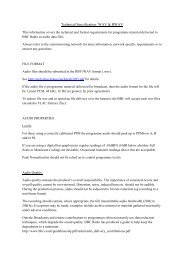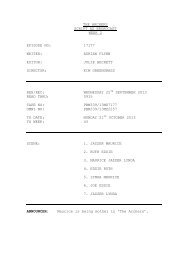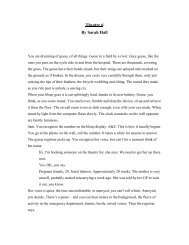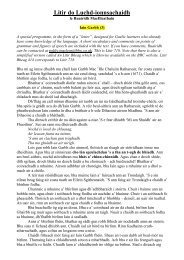50 Great British Inventions - BBC
50 Great British Inventions - BBC
50 Great British Inventions - BBC
Create successful ePaper yourself
Turn your PDF publications into a flip-book with our unique Google optimized e-Paper software.
00 10<br />
18 Steam turbine<br />
Invented 1884 Inventor Charles Parsons<br />
After the invention of the electrical motor<br />
– which transforms rotation into electrical<br />
power – the next step was to find a device<br />
to drive it. Piston engines vibrated too<br />
violently, so the steam turbine, invented<br />
by Newcastle-based engineer Charles<br />
Parsons in 1884, was the answer.<br />
The turbine is like a windmill – steam<br />
blasts the turbine blades and turns them<br />
round. What Parsons came up with was<br />
a means of extracting every last ounce of<br />
19 Marine chronometer<br />
Invented 1761 Inventor John harrIson 21<br />
Accurate navigation at sea has always<br />
been critically important but, until the<br />
invention of the marine chronometer, it<br />
was extremely difficult, if not impossible.<br />
Latitude was straightforward to measure;<br />
the problem was longitude. In 1714,<br />
some 200 years after sailing ships<br />
had first circumnavigated the<br />
world, the <strong>British</strong> government<br />
announced a £20,000 prize<br />
– worth almost £3m today<br />
– for anyone who could<br />
solve the problem.<br />
The key to it was<br />
making a clock that<br />
could somehow keep<br />
power from the steam. He made the<br />
gaps between the blades very small so<br />
that the steam would accelerate through<br />
the turbine. He also realised you could<br />
channel the steam through multiple sets<br />
of blades in sequence, each one capturing<br />
the steam from the one before. Three<br />
quarters of the world’s power stations<br />
still use steam. Whether steam-powered<br />
or not, every station uses the theory<br />
behind Parsons’s innovation. <br />
accurate time despite being pitched<br />
around by wind and waves and exposed<br />
to great variations in temperature and<br />
humidity. John Harrison, a self-taught<br />
clockmaker, devoted his life to the task.<br />
He began building his first attempt in<br />
1730, but 30 years went by before he<br />
cracked it. The H4 timepiece lost just five<br />
seconds between England and Jamaica<br />
and contained numerous horological<br />
innovations. After lengthy disputes with<br />
the Board of Longitude, Harrison finally<br />
got his reward in 1773. His clocks were<br />
carried by the likes of James Cook and<br />
William Bligh, and safe long-distance<br />
travel was now possible. <br />
DID YOU KNOW?<br />
the turbinia<br />
(1894), the first<br />
ship powered by<br />
a steam tUrbine,<br />
was the fastest<br />
in the world at<br />
the time. see it<br />
at newCastle’s<br />
disCovery<br />
mUseUm.<br />
RadioTimes <strong>50</strong> <strong>Great</strong> <strong>British</strong> <strong>Inventions</strong><br />
20 Synthetic<br />
dye<br />
Invented 1856<br />
Inventor WIllIam PerkIn<br />
In 1856, William Perkin was a precocious<br />
18-year-old studying at the Royal College of<br />
Chemistry when he discovered how to make<br />
the world’s first synthetic dye – mauveine.<br />
The search for how to make synthetics was<br />
at the cutting edge of chemistry at the time,<br />
and Perkin was assisting his professor’s hunt<br />
for an artificial way to make the anti-malarial drug<br />
quinine. Working in his makeshift lab at home one<br />
day during the university holidays, he was using<br />
alcohol to clean out some chemical residue<br />
from a flask when he suddenly saw an<br />
intense purple colour<br />
appear. At the time, dyes<br />
were made from natural<br />
extracts, and were<br />
expensive and faded easily.<br />
Purple came only from the<br />
glands of particular species of<br />
molluscs and was among the<br />
priciest. Perkin worked out how<br />
to reproduce his new colour,<br />
then, keeping it secret from<br />
his professor, he patented<br />
the method and set up<br />
a company to produce it.<br />
Mauve, as it came to be<br />
known, and other synthetic dyes that<br />
followed it transformed the fashion and<br />
the textile industry. And the chemistry<br />
of dyes would have many uses in<br />
medicine, too. <br />
Hip replacement<br />
Invented 1962 Inventor John Charnley<br />
<strong>British</strong> surgeon Sir John Charnley<br />
pioneered the idea that a human hip<br />
joint could be replaced. He designed the<br />
joint and, in 1962, performed the first<br />
successful hip-replacement operation,<br />
at Wrightington Hospital in Lancashire.<br />
Charnley’s design used a femoral stem<br />
and ball made of steel and a hip socket<br />
made of Teflon – later replaced with<br />
harder-wearing polyethylene. Both<br />
parts were glued to the bone using<br />
an acrylic bone cement.<br />
Charnley also introduced important<br />
new improvements to surgical<br />
DID YOU KNOW?<br />
it was said that<br />
the Grand Union<br />
Canal woUld<br />
ChanGe ColoUr<br />
dependinG on<br />
what perkin<br />
was workinG on<br />
in his nearby<br />
west london<br />
dyeworks.<br />
procedure to reduce the chances of<br />
infection: clean air enclosures, suits<br />
for the surgical team that covered their<br />
entire bodies, and a system of sterile<br />
instrument trays. He also taught<br />
surgeons from all over the world.<br />
Although many improvements have<br />
been made since – to the design of the<br />
joint, the surgical method and the ways<br />
of fixing the replacement joint to the<br />
bone – Charnley set the standard.<br />
Today, 80,000 hip replacements are<br />
performed in Britain each year, and<br />
almost a million a year worldwide. <br />
dan snoW<br />
22 Passenger<br />
railway<br />
Invented 1825<br />
Inventor GeorGe stePhenson<br />
one of my favourite <strong>British</strong><br />
innovations is George Stephenson’s<br />
passenger railway. Stephenson’s<br />
parents were illiterate, his mother<br />
dying of tB when he was a child<br />
and his father later blinded in an<br />
industrial accident. It was a<br />
remarkable background for a man who would<br />
forge a communications revolution.<br />
While working as a miner, Stephenson enrolled<br />
in night school where he learnt to read and write,<br />
at age 18. He established an aptitude as a mechanic<br />
and was allowed to build machines at his colliery.<br />
At the time, carts on tracks, pulled by horses, were<br />
used to take coal from the many collieries around<br />
newcastle to the tyne, from where it could be<br />
exported by ship. Stephenson started to innovate.<br />
He improved the design of cast-iron rails to<br />
strengthen them, but above all he used steam<br />
engines to replace horse power.<br />
Machines that harnessed the power of steam<br />
to push, lift or pull had been around for a while;<br />
Stephenson improved them and developed<br />
workable solutions to ensure that rather than<br />
remaining static, these steam engines could<br />
actually run on tracks. the result was a rapid<br />
succession of world firsts: the first “flanged-wheel<br />
adhesion locomotive”. the first trackway or railway<br />
using only locomotives — no horses at all. the first<br />
purpose-built passenger car, which ran on the<br />
world’s first regular passenger-carrying railway, the<br />
Stockton and darlington. the world’s first intercity<br />
railway, between Liverpool and Manchester.<br />
Stephenson’s system of train coupling became<br />
the european standard and his chosen gauge,<br />
or distance between the two rails, of 4ft 8 1 /2in<br />
(1.435m) has become the world’s standard gauge,<br />
adopted nearly universally. We are still carried<br />
along by the revolution that he began. <br />
Locomotion: Dan Snow’s History of Railways<br />
starts on Tuesday at 9.00pm on <strong>BBC</strong>2<br />
11

















